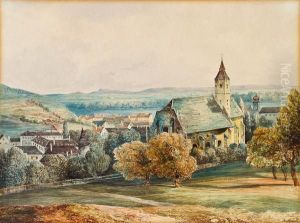Moritz Leybold Paintings
Moritz Leybold was a German-born artist known for his contributions to lithography, a printing process that was innovative during his time. Born in 1805 in Stuttgart, Germany, Leybold showed an early interest in the arts and quickly developed a strong foundation in various artistic techniques.
Leybold was trained in the fine arts and initially started his career as a painter. However, he found his true calling in the field of lithography, which was a relatively new medium when he began his explorations. Lithography, invented at the end of the 18th century by Alois Senefelder, offered artists the ability to produce images through a unique printing process that involved drawing on limestone with oil-based inks or crayons and then using that to transfer images onto paper.
Throughout his career, Leybold became proficient in this technique and was known for his detailed and high-quality lithographic prints. His works often included portraits, landscapes, and genre scenes, reflecting the interests and styles of the time. He also became involved in the production of illustrated books, contributing his lithographs to enhance the visual appeal of literary works.
In addition to his artistic endeavors, Leybold played a significant role in the advancement and dissemination of lithography as a medium. He was active in teaching and sharing his knowledge with other artists, which helped establish lithography as a respected form of artistic expression and a practical method of reproduction.
Moritz Leybold passed away in 1879, leaving behind a legacy that not only included his own artworks but also his influence on the field of printmaking. His dedication to lithography helped ensure its place in the history of art, and his prints continue to be studied and appreciated for their technical skill and artistry.
